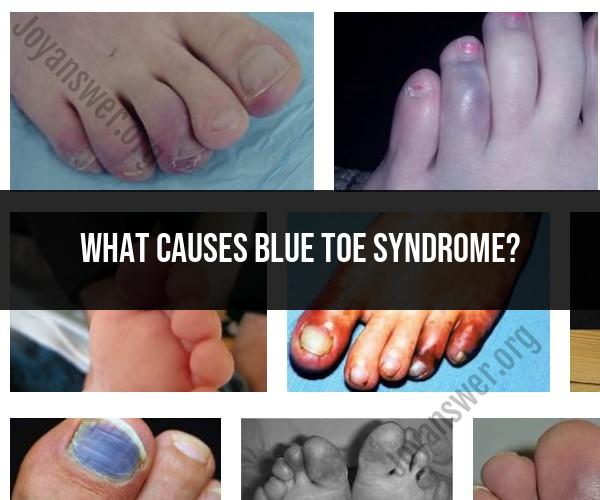What causes blue toe syndrome?
Blue toe syndrome, also known as blue toe syndrome or trash foot, is a condition characterized by the sudden development of blue or purple discoloration of one or more toes. It is typically a manifestation of an underlying vascular or circulatory problem. Several underlying causes can contribute to blue toe syndrome, including:
Emboli: One of the most common causes of blue toe syndrome is the presence of emboli, which are small blood clots or plaques that can block the arteries supplying blood to the toes. These emboli can originate from various sources, such as the heart (e.g., in cases of atrial fibrillation or valvular heart disease) or the aorta (e.g., in cases of aortic aneurysms or atherosclerosis). When an embolus lodges in a small artery of the toe, it can disrupt blood flow and cause tissue damage.
Atheroembolism: Atheroembolism occurs when atherosclerotic plaques within larger arteries break loose and travel to smaller arteries, obstructing blood flow. This can lead to blue toe syndrome.
Thrombosis: The formation of blood clots (thrombosis) within the arteries of the foot or toe can block blood flow and cause discoloration.
Vasculitis: Inflammation of the blood vessels, known as vasculitis, can damage the arteries and disrupt blood flow. Vasculitis can be caused by various autoimmune diseases or other underlying conditions.
Arterial Dissection: In some cases, an arterial dissection (a tear in the arterial wall) can lead to blue toe syndrome, especially when the dissection affects the arteries in the lower extremities.
Symptoms of Blue Toe Syndrome:
The primary symptom of blue toe syndrome is the sudden appearance of blue or purple discoloration in one or more toes. Other symptoms and signs may include:
- Pain or discomfort in the affected toes.
- Coldness in the toes.
- Weak or absent pulses in the affected foot.
- Decreased sensation or numbness in the affected area.
- Skin changes, such as skin ulcerations or gangrene (tissue death) in severe cases.
Blue toe syndrome is considered a medical emergency because it can indicate compromised blood flow to the toes, which, if not addressed promptly, can lead to tissue damage and even amputation.
If you or someone you know experiences symptoms of blue toe syndrome, it is crucial to seek immediate medical attention. Early diagnosis and treatment are essential to determine the underlying cause and restore proper blood flow to the affected toes to prevent further complications. The specific treatment approach will depend on the cause and severity of the condition but may include medications to dissolve clots, surgery to remove emboli or repair damaged arteries, and lifestyle modifications to manage underlying vascular conditions.
Blue Toe Syndrome: Causes, Symptoms, and Treatment
Blue toe syndrome, also known as digital ischemia, is a condition that causes the toes to turn blue due to a lack of blood flow. It is most commonly caused by a blockage in the small blood vessels that supply blood to the toes.
Causes
The most common cause of blue toe syndrome is a blockage in the small blood vessels that supply blood to the toes. This blockage can be caused by a number of factors, including:
- Atherosclerosis: Atherosclerosis is a condition in which plaque builds up on the walls of the arteries. This plaque can narrow or block the arteries, reducing blood flow to the toes.
- Embolism: An embolism is a blockage in a blood vessel caused by a blood clot, air bubble, or other foreign object. Embolisms can travel to the toes and block the small blood vessels that supply blood to the toes.
- Raynaud's disease: Raynaud's disease is a condition that causes the blood vessels in the fingers and toes to narrow in response to cold or stress. This can reduce blood flow to the toes and cause them to turn blue.
- Other medical conditions: Blue toe syndrome can also be caused by other medical conditions, such as diabetes, frostbite, and peripheral artery disease.
Symptoms
The main symptom of blue toe syndrome is blue toes. The toes may also be painful, cold, and numb. In severe cases, the toes may turn black and die.
Treatment
Treatment for blue toe syndrome depends on the underlying cause. If the cause is a blockage in the small blood vessels, treatment may include medications to thin the blood or surgery to remove the blockage. In some cases, the toes may need to be amputated.
If the cause of blue toe syndrome is Raynaud's disease, treatment may include medications to widen the blood vessels or lifestyle changes, such as avoiding cold temperatures and stress.
Understanding Blue Toe Syndrome: Vascular Insights
Blue toe syndrome is a vascular condition, meaning that it is caused by a problem with the blood vessels. The blood vessels that supply blood to the toes are very small and delicate. When these blood vessels become blocked, it can reduce blood flow to the toes and cause them to turn blue.
There are a number of factors that can increase the risk of developing blue toe syndrome, including:
- Age: Blue toe syndrome is more common in older adults.
- Smoking: Smoking damages the blood vessels and increases the risk of developing atherosclerosis.
- High blood pressure: High blood pressure can damage the blood vessels and increase the risk of developing blood clots.
- Diabetes: Diabetes can damage the blood vessels and increase the risk of developing atherosclerosis and peripheral artery disease.
- High cholesterol: High cholesterol can contribute to the formation of plaque in the arteries.
- Cold temperatures: Cold temperatures can trigger Raynaud's disease and reduce blood flow to the toes.
Vascular Conditions Unveiled: Blue Toe Syndrome Explained
Blue toe syndrome is a serious vascular condition that can lead to tissue damage and amputation if not treated promptly. It is important to be aware of the signs and symptoms of blue toe syndrome and to seek medical attention immediately if you experience any of them.
There is no one-size-fits-all treatment for blue toe syndrome. Treatment will depend on the underlying cause and the severity of the condition. In some cases, blue toe syndrome can be managed with lifestyle changes and medications. In other cases, surgery may be necessary to remove the blockage in the blood vessels.
If you have any concerns about your risk of developing blue toe syndrome, or if you are experiencing any of the symptoms of blue toe syndrome, please talk to your doctor.













